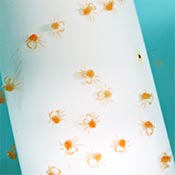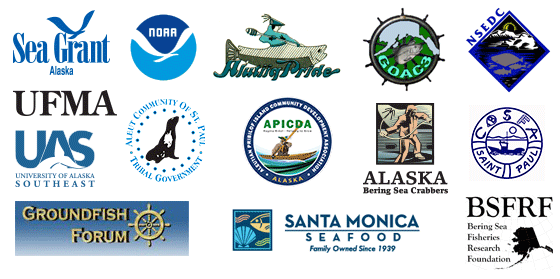Kodiak red king crab successfully reared at hatchery for release experiments
 Kodiak red king crab larvae produced at the Alutiiq Pride Shellfish Hatchery in spring 2014.
Ginny Eckert photo. Click image for larger version [1.2 MB].
Kodiak red king crab larvae produced at the Alutiiq Pride Shellfish Hatchery in spring 2014.
Ginny Eckert photo. Click image for larger version [1.2 MB].AKCRRAB researchers reared red king crab larvae at the Alutiiq Pride Shellfish hatchery this spring. The goals of the rearing season were to produce juveniles for outplanting research and to further test and refine hatchery protocols. Akhiok residents collected adult female crabs in fall 2013 from Alitak Bay on Kodiak Island in cooperation with NOAA Kodiak lab staff, who shipped the crabs to the hatchery in Seward. After hatching in March, larvae were fed two different diets and reared in six 1200 liter rearing tanks at a density of 50 larvae per liter. One larval diet consisted of enriched Artemia (brine shrimp) alone while the other was a mixed diet of enriched Artemia and two species of microalgae (Thalassiosira weissflogii and Chaetoceros muelleri). Survival to the glaucothoe (last larval) stage was greater than 50% for both diets, averaging 59% ± 6% standard error in tanks fed enriched Artemia alone, compared to 52% ± 2% survival in the tanks fed the mixed diet. Larval rearing temperature averaged 9°C, and rearing period to the glaucothoe stage was 27 days. Overall, 199,920 glaucothoe were produced. The glaucothoe and juveniles are currently being reared at the hatchery, and the juveniles will be shipped to Kodiak this summer for release experiments.
News Flash is edited by Asia Beder and Ginny Eckert. AKCRRAB, the Alaska King Crab Research, Rehabilitation and Biology Program, is sponsored by Alaska Sea Grant, UAF School of Fisheries and Ocean Sciences, NOAA Fisheries, the Alutiiq Pride Shellfish Hatchery, community groups, and industry members.

